Identification of Cabbage Seedling Defects in a Fast Automatic Transplanter Based on the maxIOU Algorithm
Abstract
:1. Introduction
2. Materials and Methods
2.1. Experimental Site and Cabbage Cultivars
2.2. Image Acquisition
2.3. Color Space Analysis
2.4. Segmentation Threshold Calculated by the maxIOU Algorithm
2.5. Identification of Seedling Defects
2.6. Identification of Cabbage Seedling Defects Procedure
- Step 1: Some images were randomly selected as Training Set 1 from the dataset and manually labeled as the substrate and seedling region.
- Step 2: The RGB color space G channel and the excel green color space (Formula (1)) of Training Set 1 were used as the image segmentation color space.
- Step 3: The images in Training Set 1 were segmented using a threshold of 0–255 and morphologically repaired. IOU was calculated with image segmentation results and labelled images. The threshold corresponding to the maximum IOU was the segmentation threshold.
- Step 4: Some of the images in the dataset were randomly selected as Training Set 2 and manually labeled as the normal group and defect group (including the defects of empty conveyor belt, seedling deficiency, skew, multiple seedlings, and substrate damage).
- Step 5: The image processing method was used to calculate the feature values of the image: arease, areasu (Equation (8)), and c (Equation (9)). Feature scatter plots were used to analyze normal and defect group sample characteristics, and the threshold with the highest classification accuracy rate was used as the defect identification threshold.
- Step 6: Identification of cabbage seedling defects: The images in the G channel and excess green color space were segmented with the threshold obtained in Step 3. The values of arease, areasu (Equation (8)), and c (Equation (9)) were calculated, and cabbage seedling defects were identified based on the threshold calculated in Step 5.
3. Experimental Results and Discussion
3.1. Image Segmentation Threshold Calculation and Result Analysis
3.2. Defect Identification Threshold Calculation and Result Analysis
3.3. The Result of Seedling Defects’ Identification
4. Conclusions
Author Contributions
Funding
Conflicts of Interest
References
- Chiu, Y.C.; Hsu, W.C.; Chang, Y.C. Detecting cabbage seedling diseases by using chlorophyll fluorescence. Eng. Agric. Environ. Food 2015, 8, 95–100. [Google Scholar] [CrossRef]
- Wei, D.; Huang, Y.; Chunjiang, Z.; Xiu, W. Identification of seedling cabbages and weeds using hyperspectral imaging. Int. J. Agric. Biol. Eng. 2015, 8, 65–72. [Google Scholar]
- Benoit, L.; Semaan, G.; Franconi, F.; Belin, É.; Chapeau-Blondeau, F.; Demilly, D.; Rousseau, D. 3D Multimodal Simulation of Image Acquisition by X-ray and MRI for Validation of Seedling Measurements with Segmentation Algorithms; Lecture Notes in Computer Science (Including Subseries Lecture Notes in Artificial Intelligence and Lecture Notes in Bioinformatics); Springer: Zurich, Switzerland, 2015. [Google Scholar]
- Lu, X.; Li, X.; Chai, Y.; Li, X. Seedling image segmentation and feature extraction under complicated background. Commun. Comput. Inf. Sci. 2014, 461, 387–399. [Google Scholar]
- Cheng, Y.Z.; Chen, Y. Corn seedling image segmentation using PCA and CV model. J. Comput. Inf. Syst. 2015, 11, 7825–7832. [Google Scholar]
- Yang, Y.; Chu, Q.; Yang, Y.; Zhang, X.; Xu, X.; Gu, S. Online grading method for tissue culture seedlings of Spathiphyllum floribundum based on machine vision. Nongye Gongcheng Xuebao Trans. Chin. Soc. Agric. Eng. 2016, 32, 33–40. [Google Scholar]
- Tong, J.; Shi, H.; Wu, C.; Jiang, H.; Yang, T. Skewness correction and quality evaluation of plug seedling images based on Canny operator and Hough transform. Comput. Electron. Agric. 2018, 155, 461–472. [Google Scholar] [CrossRef]
- Feng, Q.; Liu, X.; Jiang, K.; Fan, P.; Wang, X. Development and experiment on system for tray-seedling on-line measurement based on line structured-light vision. Nongye Gongcheng Xuebao Trans. Chin. Soc. Agric. Eng. 2013, 29, 143–149. [Google Scholar]
- Liao, J.; Wang, Y.; Yin, J.; Liu, L.; Zhang, S.; Zhu, D. Segmentation of rice seedlings using the YCrCb color space and an improved Otsu method. Agronomy-Basel 2018, 8, 269. [Google Scholar] [CrossRef] [Green Version]
- Li, K.; Feng, Q.; Zhang, J. Co-Segmentation algorithm for complex background image of cotton seedling leaves. Jisuanji Fuzhu Sheji Yu Tuxingxue Xuebao J. Comput.-Aided Des. Comput. Gr. 2017, 29, 1871–1880. [Google Scholar]
- Wang, X.; He, D.; Song, H. Machine vision based quantitative analysis method for seedling root system of maize images. Int. Agric. Eng. J. 2018, 27, 380–392. [Google Scholar]
- Caicedo, J.C.; Roth, J.; Goodman, A. Evaluation of deep learning strategies for nucleus segmentation in fluorescence images. Cytom. Part A 2019, 95, 952–965. [Google Scholar] [CrossRef] [PubMed] [Green Version]
- Rodriguez-Lozano, F.J.; Leon-Garcia, F.; Ruiz De Adana, M.; Palomares, J.M.; Olivares, J. Non-Invasive forehead segmentation in thermographic imaging. Sensors 2019, 19, 4096. [Google Scholar] [CrossRef] [PubMed] [Green Version]
- Fan, H.; Xie, F.; Li, Y.; Jian, Z.; Liu, J. Automatic segmentation of dermoscopy images using saliency combined with Otsu threshold. Comput. Biol. Med. 2017, 85, 75–85. [Google Scholar] [CrossRef] [PubMed]
- Osroosh, Y.; Peters, R.T.; Campbell, C.S.; Zhang, Q. Automatic irrigation scheduling of apple trees using theoretical crop water stress index with an innovative dynamic threshold. Comput. Electron. Agric. 2015, 118, 193–203. [Google Scholar] [CrossRef]
- Singla, A.; Patra, S. A fast automatic optimal threshold selection technique for image segmentation. Signal Image Video Process. 2017, 11, 243–250. [Google Scholar] [CrossRef]
- Ustubioglu, B.; Ulutas, G.; Ulutas, M.; Nabiyev, V.V. A new copy move forgery detection technique with automatic threshold determination. AEU–Int. J. Electron. Commun. 2016, 70, 1076–1087. [Google Scholar] [CrossRef]
- Gupta, V.; Chaurasia, V.; Shandilya, M. Random-valued impulse noise removal using adaptive dual threshold median filter. J. Visual Commun. Image Represent. 2015, 26, 296–304. [Google Scholar] [CrossRef]
- Chang, Y.C. Improving the Otsu method for MRA image vessel extraction via resampling and ensemble learning. Healthc. Technol. Lett. 2019, 6, 115–120. [Google Scholar] [CrossRef]
- Shao, L.; Zhang, Y.; Li, J.; Liu, H.; Chen, X.; Yu, X. Research on High Temperature Region Segmentation of Infrared Pipeline Image Based on Improved Two-Dimensional-Otsu. Spectrosc. Spectr. Anal. 2019, 39, 1637–1642. [Google Scholar]
- Zhan, Y.; Zhang, G. An improved OTSU algorithm using histogram accumulation moment for ore segmentation. Symmetry-Basel 2019, 11, 431. [Google Scholar] [CrossRef] [Green Version]
- Qin, J.; Shen, X.; Mei, F.; Fang, Z. An Otsu multi-thresholds segmentation algorithm based on improved ACO. J. Supercomput. 2019, 75, 955–967. [Google Scholar] [CrossRef]
- Meng, W.; Tonghai, J.; Xiao, L.; Yan, Z.; Haiwei, W. Image segmentation based on adaptive inertia weight particle swarm optimization. Revista Tecnica de la Facultad de Ingenieria Universidad del Zulia 2016, 39, 235–241. [Google Scholar]
- Bao, X.; Jia, H.; Lang, C. A novel hybrid harris hawks optimization for color image multilevel thresholding segmentation. IEEE Access 2019, 7, 76529–76546. [Google Scholar] [CrossRef]
- Ren, J.; Zeng, X. An image segmentation method of improved sobel operator. Boletin Tecnico Tech. Bull. 2017, 55, 193–199. [Google Scholar]
- Howard, M.; Hock, M.C.; Meehan, B.T.; Dresselhaus-Cooper, L.E. A locally adapting technique for edge detection using image segmentation. SIAM J. Sci. Comput. 2018, 40, B1161–B1179. [Google Scholar] [CrossRef]
- Wang, Y.; Wang, C. Computer vision-based color image segmentation with improved kernel clustering. Int. J. Smart Sens. Intell. Syst. 2015, 8, 1706–1729. [Google Scholar] [CrossRef] [Green Version]
- Koundal, D. Texture-based image segmentation using neutrosophic clustering. IET Image Process. 2017, 11, 640–645. [Google Scholar] [CrossRef]
- Shelhamer, E.; Long, J.; Darrell, T. Fully convolutional networks for semantic segmentation. IEEE Trans. Pattern Anal. Mach. Intell. 2017, 39, 640–651. [Google Scholar] [CrossRef]
- Girshick, R.; Donahue, J.; Darrell, T.; Malik, J. Region-Based convolutional networks for accurate object detection and segmentation. IEEE Trans. Pattern Anal. Mach. Intell. 2016, 38, 142–158. [Google Scholar] [CrossRef]
- Ding, S.; Nie, X.; Qiao, H.; Zhang, B. A fast algorithm of convex hull vertices selection for online classification. IEEE Trans. Neural Netw. Learn. Syst. 2018, 29, 792–806. [Google Scholar] [CrossRef]
- Zeng, M.; Yang, Y.; Zheng, J.; Cheng, J. Maximum margin classification based on flexible convex hulls for fault diagnosis of roller bearings. Mech. Syst. Signal Process. 2016, 66, 533–545. [Google Scholar] [CrossRef]



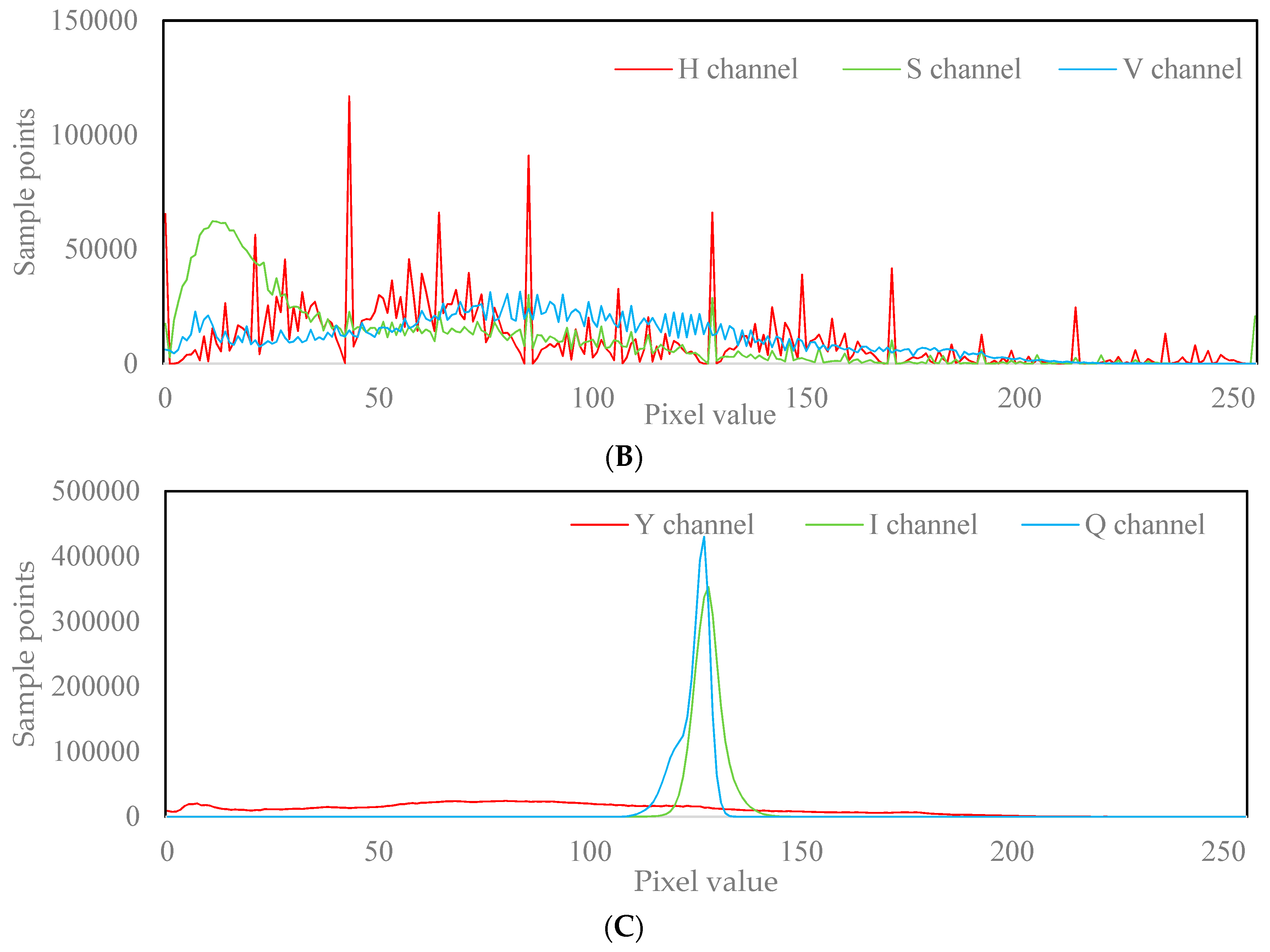
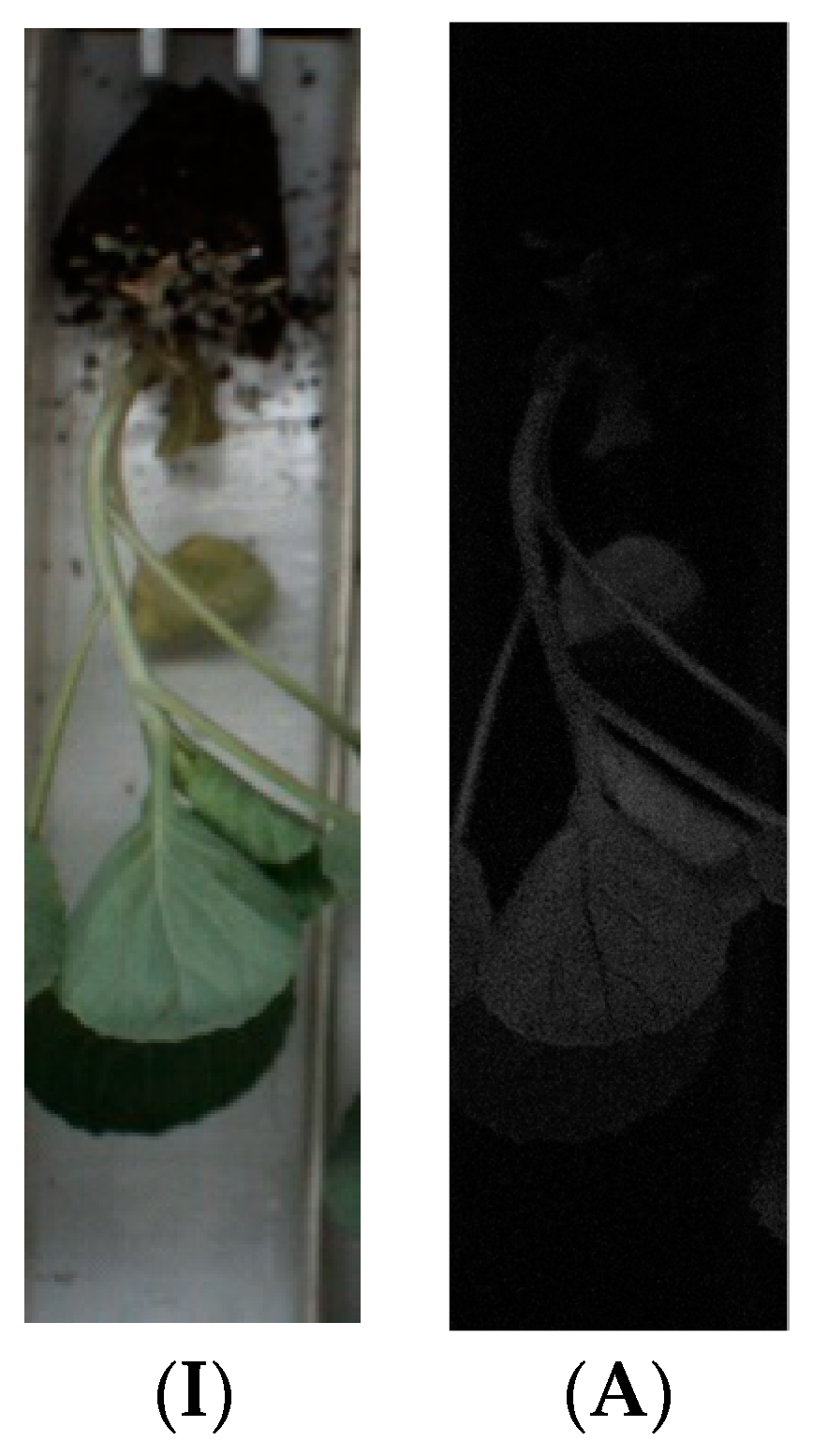






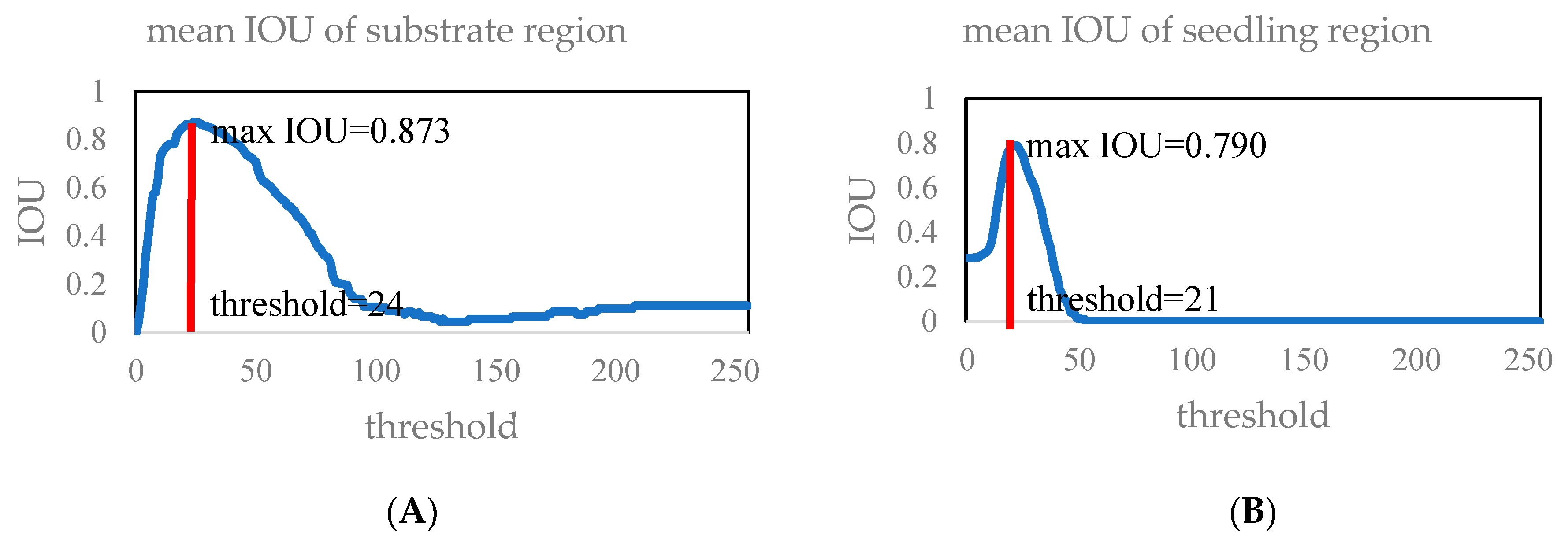
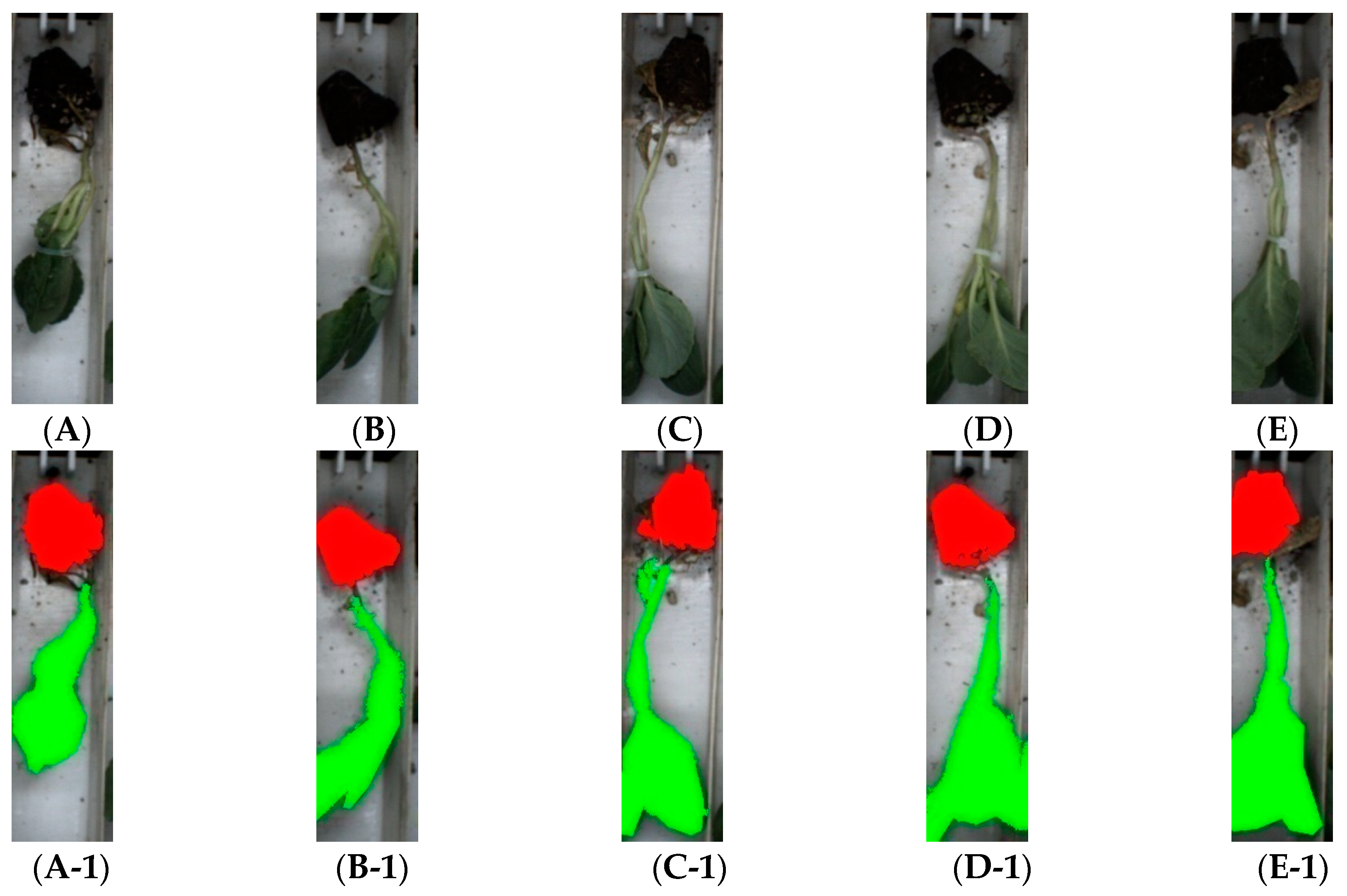
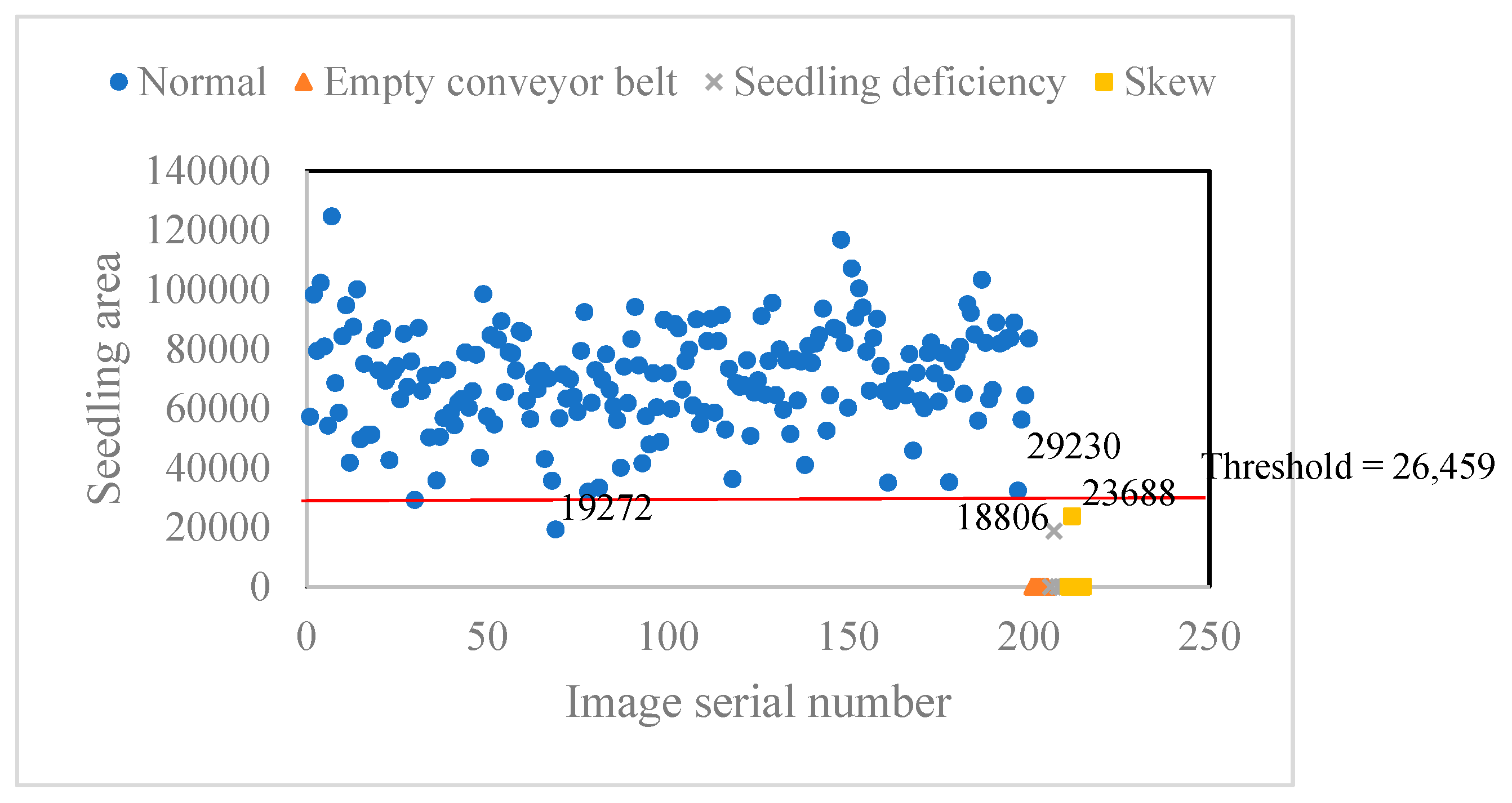
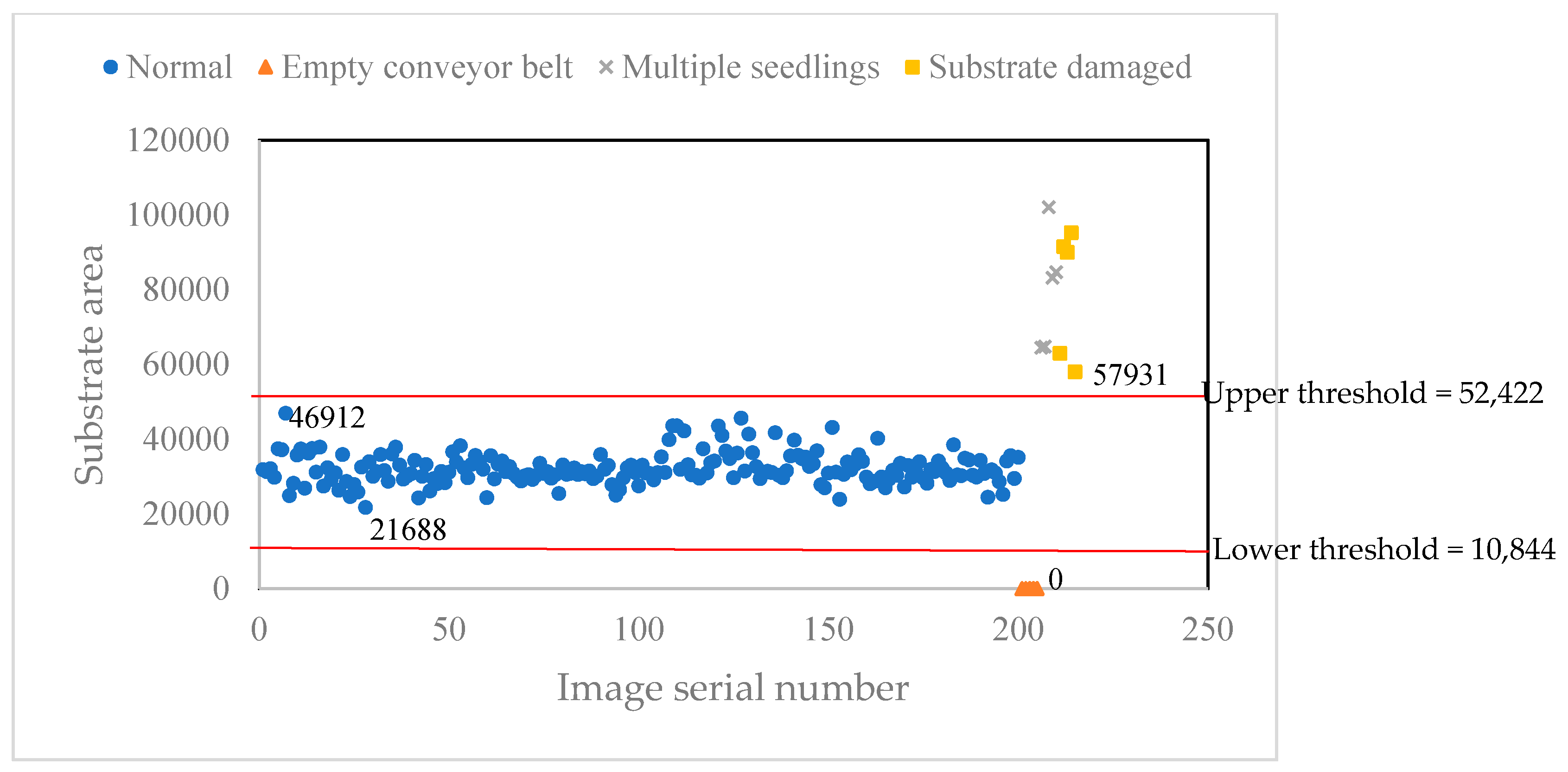
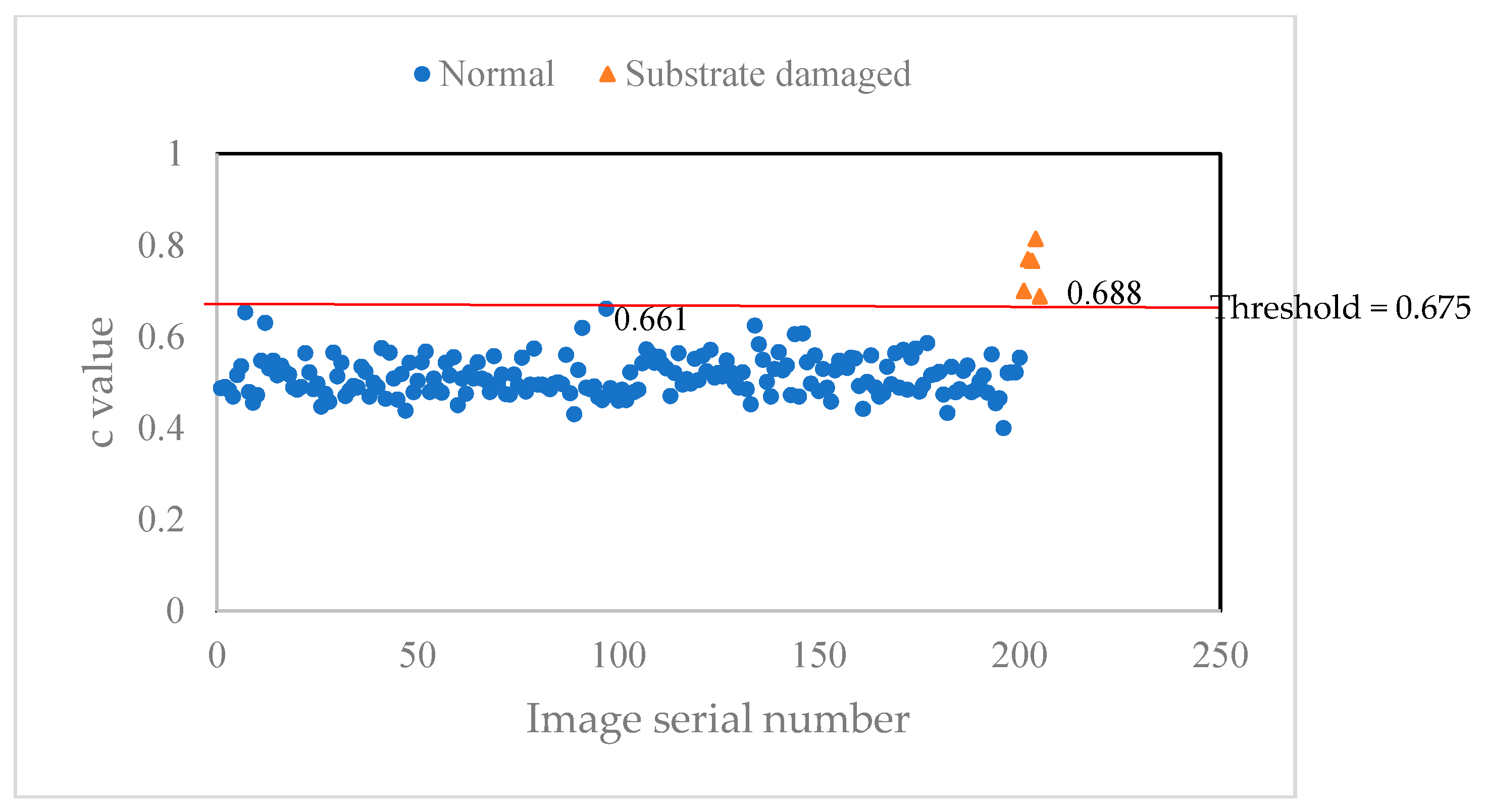
| Seedling Defects | Defects’ Characterization |
|---|---|
| Empty conveyor belt | There is no seedling on the conveyor belt |
| Seedling deficiency | There is substrate on the conveyor belt, but no seedling |
| Skew | The stem of the seedling spans the conveyor baffle |
| Multiple seedlings | There is more than 1 seedling in a conveyor belt slot |
| Substrate damage | Serious damage to the substrate structure leads to an irregular substrate shape |
| Empty Conveyor Belt | Seedling Deficiency | Skew | Multiple Seedlings | Substrate Damage | |
|---|---|---|---|---|---|
| Substrate | Area too small | - | - | Area too large | Area too large and area of the lower part too large |
| Seedling | Area too small | Area too small | Area too small | - | - |
| Classification Threshold Interval | (18,806, 19,275) | (19,275, 23,688) | (23,688, 29,230) |
|---|---|---|---|
| The number of misclassified normal images | 0 | 1 | 1 |
| The accuracy of normal images’ classification | 100% | 99.5% | 99.5% |
| The number of misclassified defect images (empty conveyor belt, seedling deficiency, and skew images) | 1 | 1 | 0 |
| The accuracy of defect images’ (empty conveyor belt, seedlings deficiency, and skew images) classification | 93.3% | 93.3% | 100% |
| Group | The Total Number | The Number of Samples Correctly Identified |
|---|---|---|
| Normal | 431 | 420 |
| Empty conveyor belt | 20 | 20 |
| Seedling deficiency | 15 | 14 |
| Multiple seedling | 6 | 6 |
| Skew | 16 | 16 |
| Seedling damaged | 12 | 12 |
| Total | 500 | 488 |
| TP | TN | FP | FN | Accuracy | Precision | Recall | Processing Time (ms) |
|---|---|---|---|---|---|---|---|
| 420 | 68 | 11 | 1 | 97.6% | 97.4% | 99.8% | 71.4 |
© 2020 by the authors. Licensee MDPI, Basel, Switzerland. This article is an open access article distributed under the terms and conditions of the Creative Commons Attribution (CC BY) license (http://creativecommons.org/licenses/by/4.0/).
Share and Cite
Zhang, G.; Wen, Y.; Tan, Y.; Yuan, T.; Zhang, J.; Chen, Y.; Zhu, S.; Duan, D.; Tian, J.; Zhang, Y. Identification of Cabbage Seedling Defects in a Fast Automatic Transplanter Based on the maxIOU Algorithm. Agronomy 2020, 10, 65. https://doi.org/10.3390/agronomy10010065
Zhang G, Wen Y, Tan Y, Yuan T, Zhang J, Chen Y, Zhu S, Duan D, Tian J, Zhang Y. Identification of Cabbage Seedling Defects in a Fast Automatic Transplanter Based on the maxIOU Algorithm. Agronomy. 2020; 10(1):65. https://doi.org/10.3390/agronomy10010065
Chicago/Turabian StyleZhang, Gan, Yongshuang Wen, Yuzhi Tan, Ting Yuan, Junxiong Zhang, Ying Chen, Sishuo Zhu, Dongshuai Duan, Jinyuan Tian, and Yu Zhang. 2020. "Identification of Cabbage Seedling Defects in a Fast Automatic Transplanter Based on the maxIOU Algorithm" Agronomy 10, no. 1: 65. https://doi.org/10.3390/agronomy10010065
APA StyleZhang, G., Wen, Y., Tan, Y., Yuan, T., Zhang, J., Chen, Y., Zhu, S., Duan, D., Tian, J., & Zhang, Y. (2020). Identification of Cabbage Seedling Defects in a Fast Automatic Transplanter Based on the maxIOU Algorithm. Agronomy, 10(1), 65. https://doi.org/10.3390/agronomy10010065




